My Basement Flooded. Now What?
Updated March 17, 2021. AmFam Team
Updated March 17, 2021. AmFam Team
When severe weather hits and leaves a basement full of water behind, you need to act quickly. Although cleaning up after a basement flood may seem like an impossible task, it is possible. So, before a storm sweeps through your area and you’re dealing with a flood on your lower level, watch this short video on what to do when your basement floods. Then, keep reading for step-by-step tips on how to manage water removal and quickly restore your basement in the aftermath of a flood.
Oh, no. Flooded basement? Don't panic. Your friends at American Family Insurance are here with tips to help prevent and repair any damage to your home.
First up. Safety. Remember that your safety is always the number one priority. Look for these key signs of danger before entering a flooded basement.
If there are outlets or electrical equipment below the waterline, you'll need an electrician to shut off the main power. Call your electrical company as soon as possible and stay out of your home until the power's off.
Another hazard you'll want to watch for is potential gas leaks. If you smell gas, leave immediately and contact your gas company.
Next, check for sewage backup that could contain hazardous bacteria or waste. If you notice, signs of sewage, stay out of the water and call a plumber.
Lastly, remember flooding can cause structural damage to your home. Don't go inside until it's determined to be structurally sound.
All right. Once you're certain your house is safe to enter, the next step is to identify the source of the flooding.
If the source is a burst pipe or broken appliance like a washing machine, turn off your main water supply. In most homes, you can do this yourself without needing to call an expert.
If your basement is flooded due to heavy rain or a natural disaster, you may have to wait until the storm passes before you can start cleanup and repairs.
If your basement is only partially flooded and you're absolutely certain it's safe to enter, you may want to remove items like electronics or valuables before the water reaches them.
OK. Now that water is no longer coming into your basement and you've confirmed it's safe to enter, it's time to get to work.
First up, call your American Family Insurance agent. If the flooding is due to a covered event, your homeowners insurance may help pay for cleaning and restoration services.
For example, if your basement suddenly floods due to a burst pipe, overflowing sink or broken appliance, it may be covered by your homeowners policy.
However, water damage caused by a flooding river or heavy downpour may not be covered by a standard insurance policy. Be sure to ask your agent about optional coverages that can help provide extra financial protection against flood damage. And remember, your agent can also help recommend contractors even if the flood damage isn't covered under your insurance.
All right. If you've decided to handle cleanup on your own, your first task is to get any remaining water out of your basement.
Use a wet/dry vacuum, water pumps, mops and buckets, or enlist the help of professional cleanup company.
After all the water is out, your next focus is to prevent mold and mildew growth. Running fans, turning on a dehumidifier and opening windows, if the weather is dry, will help lower the humidity.
If a carpeted area floods, you may need to pull up the carpet and replace the padding. If you're not ready to DIY this, don't hesitate to call an expert.
For concrete flooring, your goal is to get it completely dry. So keep running the fan or dehumidifier until it is. Remember, concrete is the foundation of your entire house, so call in a professional, if the damage is severe.
Lastly, if you have wood flooring disinfect it using a wood-friendly cleaner, then just like concrete, keep the air circulation going until it's completely dry.
There you go. Now, you have a clean, dry basement to enjoy.
Ready for more helpful homeowner tips? Contact your local agent or visit and AmFam.com American Family Insurance.
First and foremost: never walk into a room when water is present on the floor. Extension cords or other electrical wiring may be compromised and that standing water could be electrified. After making sure you and your loved ones are safe, there are other important steps to take as well. You’ll need to move quickly in order to keep mold development to a minimum.
Your homeowners insurance is typically able to cover the water damage in your basement if it’s caused by covered events like a burst pipes and sudden leaks caused by accidental damage. Water damage caused by flooding that results from a storm probably won’t be covered by your homeowners insurance though.
To protect your basement from this type of flooding and for greater peace of mind, consider purchasing a separate flood insurance policy through the National Flood Insurance Program (NFIP). If you have a separate flood policy through the NFIP, file a claim or contact your American Family Insurance agent once you notice the flooding damage and after everyone is safe.
In addition to working with our Emergency Water Removal Program, here’s a list of things to do to within the first 24 hours after a flood to get your basement back in shape quickly:
If necessary, contact a licensed electrician to disconnect the power to the basement. Be sure you’ve got high-powered, battery-operated flashlights or flood lamps to help you navigate safely.
Industrial tool rental groups will usually have pumps and hoses suitable for basement flooding repair.
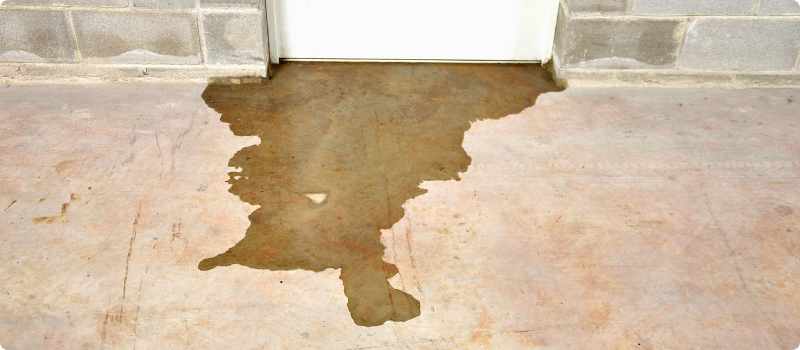
Once you’ve got the majority of the water out, you’ll need to understand how the basement flood happened. It’s smart to first check your sump pump — did it stop working? When it’s safe to do so, power up the sump pump and see if it’s still working. If it is, let the sump collect the rest of the water.
There are a few other places to check in your basement that could have caused the flooding. Be sure to inspect the following:
Get all items that have been impacted by the flood water out of the basement. Painful as this may be, that may include your flooring. You may have to pull up the carpet, padding and other flooring with this type of water damage. When water has made its way into flooring, mold can develop quickly and that can present serious health issues for you and your family.
After the water’s up, it’s time to kick the humidity out of your basement. Check back with the tool rental group and reserve a couple of fans to dry out what’s left behind.
Along with airflow, getting the moist air out of your basement is the next step in returning it to a usable space. Be sure to run a hose to a drain — if possible — or empty the water collection bin regularly. Your local tool rental outfit may have industrial dehumidifiers that can really help to pull moisture out.
You’ll need to dry out your basement’s floor right away to prevent future damage to your basement or costly repairs down the line. The drying process depends on the type of flooring material your basement has, so follow the steps for your basement’s flooring below.
If you’re wondering how to handle wall-to-wall carpeting after a flood, you may be able to salvage the carpeting, but the padding will have to be pulled up and replaced. Here’s how to dry your carpeting after a flood. Be sure to follow the final step to prevent mold from forming.
Use the wet-dry vac to pull water up as much as possible from the carpeting. Think about renting a carpet cleaner to pull water and shampoo the carpet before you pull it up.
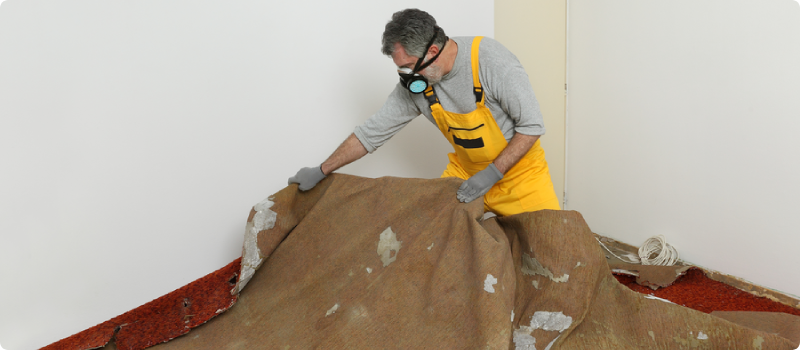
Wall-to-wall carpeting is attached to your floor with a tacking strip along the perimeter. Pull the carpet up off the floor and tent it over chairs and ladders.
Direct fans above and below the tented carpeting and use your dehumidifier to assist.
Your padding will likely not be recoverable and will need to be pulled up and thrown away. Get in touch with a carpet installer and get a quote on new padding and re-installing your dried carpeting, if you’re not up to the job yourself.
After you’ve dried the carpet and the cement pad is dry, get cleaning chemicals and materials that inhibit the growth of mold and mildew. Apply these chemicals carefully and be sure to follow the safety instructions. Proper ventilation and personal protection equipment — like a respirator — may be required. Hiring a professional steam cleaning group to sanitize the carpeting after it’s re-installed can also help prevent mold from growing.
If the flooding isn’t too bad, you may think your concrete floor will dry up no problem on its own once the excess water is removed. However, not properly drying your concrete floor after flooding can cause it to crack or fail to bond with water-based adhesive used in things like carpet. Here’s how to dry your concrete basement floor after flooding.
Just like carpeting, remove the standing water by mopping it up, draining it or using a sump pump if severe.
Next open windows to get air circulating in your basement. A dehumidifier is preferred if your flooding was substantial, as it can really help remove remaining moisture.
If your flooding was severe, you’ll need professionals to assess the damage. As concrete is the foundation of your house, you don’t want to risk it becoming more damaged, so consider hiring a professional concrete drying company.
Like carpet and concrete, drying your wood floor after a flood immediately is crucial. Wood in particular can discolor or warp when wet, so act fast and follow these steps.
Leaving furniture or heavy appliances on wet wood floor can cause damage, so move those items right away and dry them elsewhere.
A wet-dry vacuum is your best bet for removing as much water from your wood flooring as possible. If there’s a lot, consider hiring a water damage restoration company for help.
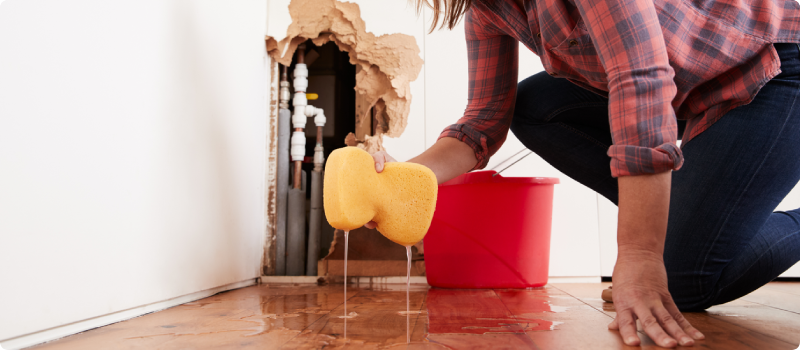
Hardwood flooring is susceptible to mold if too wet, so use a wood floor-friendly disinfectant to clean the floor after the standing water has been removed.
To start drying, use a dehumidifier in the center of your basement. This will be a big help for removing moisture, but you can use large fans if you don’t have a dehumidifier. Turn on the air conditioning in your basement — that will help too.
It can take up to six weeks to completely dry your basement floor, so wait before having your floor sanded or refinished. If your floor still seems wet, contact a professional.
A great initial step to preventing water damage caused by flooding is investing in a water leak sensor. When placed in flood-prone areas, these devices can detect water leaks, shut off the water main and alert you via your smartphone.
To help protect your home and what matters most, here are more ways you can help prevent basement flooding.
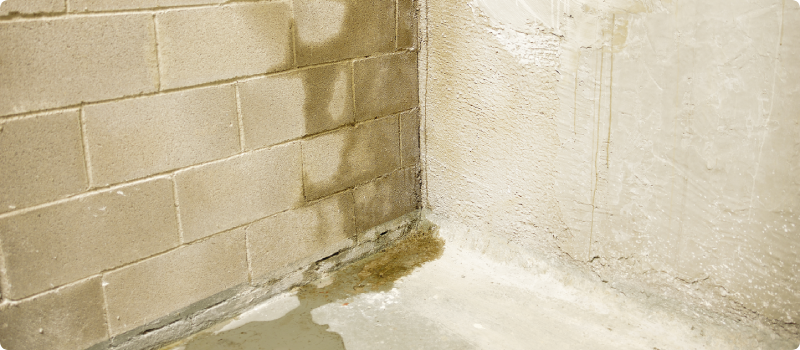
Check your home’s concrete foundation for any cracks or signs of stress. That includes the exterior if visible, and your basement’s floor and walls. You can use epoxy to repair small cracks, but you’ll need professional help if serious.
Rainwater can pool and seep into your home if your gutters or downspouts are clogged with debris. Regularly clean your gutters and make sure your downspouts end at least three feet away from your home so water will freely flow away.
Water can collect in window wells and seep through to your basement floor. Securing your window wells with clear acrylic covers will help to keep out water — leaves and critters too — and best of all, they let sunlight in.
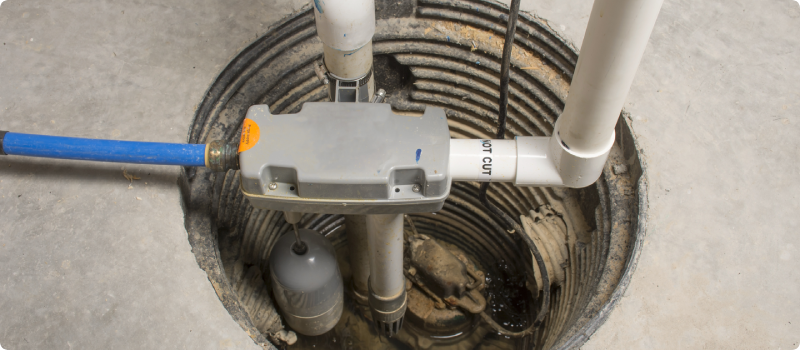
Your sump pump is responsible for preventing water damage to your home, but it can fail due to a clog or power outage. Be sure to regularly inspect your sump pump to make sure it is running correctly. Learn more about sump pump maintenance and how sump pump insurance coverage can protect your home from sump pump failure.
Lawn regrading is leveling out your yard so that any slopes rainwater can travel down toward your house are smoothed out. A little landscaping can go a long way in making sure rainwater drains away from your home and basement.
Cleaning up after a flood can feel like a job that will take weeks. But the majority of the work is setting up the space to keep humidity down while things dry out. It can be hard to determine who to call when basement floods, but you’re not in this alone!
A great resource in the event of a basement flood is your American Family Insurance agent. Before the storms start rumbling, they can help you determine if you’ll benefit from optional coverage like hidden water damage or sump pump failure. And of course, if the unexpected happens, they’ll be right there to help you file your claim.
This information represents only a brief description of coverages, is not part of your policy, and is not a promise or guarantee of coverage. If there is any conflict between this information and your policy, the provisions of the policy will prevail. Insurance policy terms and conditions may apply. Exclusions may apply to policies, endorsements, or riders. Coverage may vary by state and may be subject to change. Some products are not 40 available in every state. Please read your policy and contact your agent for assistance.